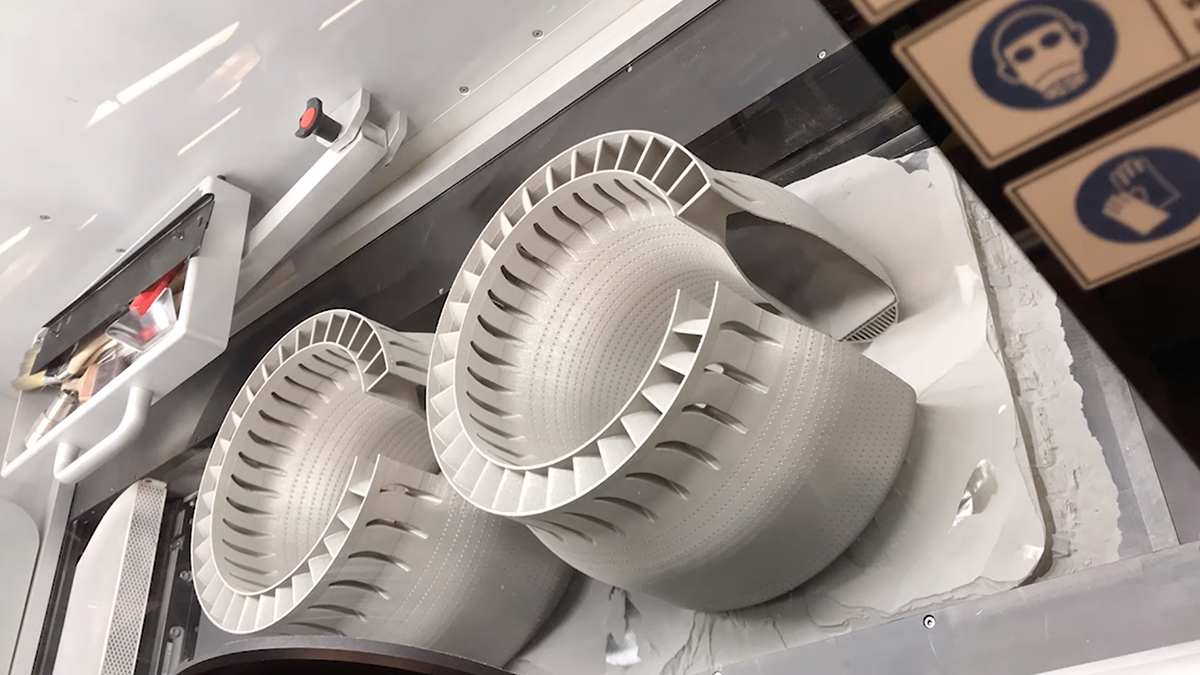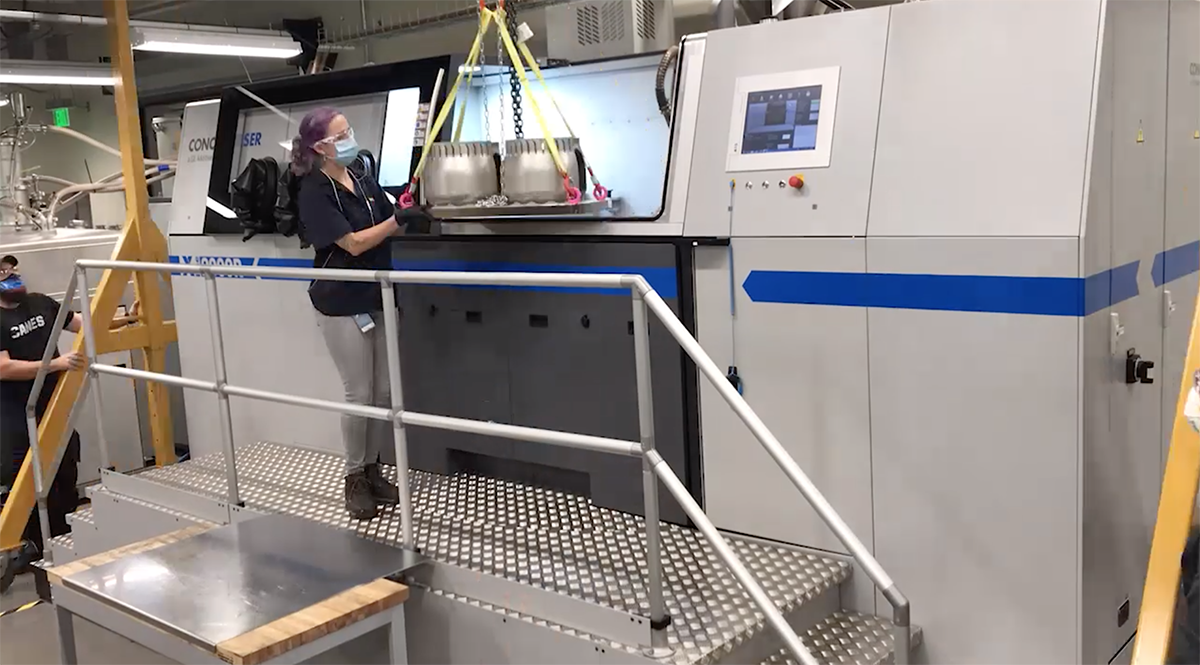With a new GE Additive X Line installed and running at its Raleigh facility, we caught up with Protolabs’ David Bentley, GE Additive’s René de Nazelle and AP&C’s Javier Arreguin to find out more

Why did you go down the route of installing another X Line and which specific material will be you using?
David Bentley: We continue to see demand for larger parts and production parts, so it was only natural to expand our capacity and add a new material option for large-format printing. We’ve had good success with our X Line running nickel alloy 718, so we were excited to add a second machine running AlSi10Mg.
Why did you opt for that material?
David Bentley: AlSi10Mg is pretty standard in the additive world these days. We’ve been running this alloy in our M2s and Mlabs for years, so we have a high level of familiarity with the material. It’s nice to build with, and post-processing is relatively simple compared to some of the popular superalloys that use titanium or nickel. Aluminum has been the most-requested material for large parts across our customer base. It’s also a good multipurpose material that is requested for end-use parts across multiple industries. So, rather than focus on one industry segment, we are aiming to provide an offer that appeals to multiple industries like aerospace, automotive, industrial, oil and gas, etc.
Javier Arreguin: Of the many metals out there, aluminum shows the best balance of properties, making it an ideal choice for many applications. People choose it when cost is critical in low-temperature applications. In addition, aluminum has roughly a third of the density of steel or nickel alloys. This means that for the same part size (and volume), aluminum will weigh three times less, resulting in significant weight savings.
What are some of the benefits of using aluminum to create parts?
David Bentley: In general, aluminum alloys have been used most often in applications due to their high strength-to-weight ratio, good conductivity and corrosion resistance. AlSi10Mg is a traditional casting alloy that is well-suited for 3D printing. Using a heated build plate, it’s able to print with low residual stress. This enables higher rates of first-print success and less development work, which is especially beneficial when part size is large and build cost is high.
Javier Arreguin: We need to remember that aluminum is the second-most-used metal worldwide due its excellent physical and mechanical properties. Provided it’s not subjected to high heat environments (beyond 100°C), it’s lighter and a cost-effective option compared to other metals and metal alloys. In sectors such as automotive, the use of aluminum alloys creates new business opportunities to increase the adoption of additive manufacturing.
Which industries will be interested in this combination of X Line and aluminum? What might some of the typical/ atypical uses and applications customers could explore?
David Bentley: We see aluminum as a popular material choice in all industries that we serve – medical, computer electronics, industrial, aerospace and automotive. Typically, larger components come from the aerospace or automotive segments. Any application that requires high strength-to-weight ratios can benefit from AlSi10Mg. Complex designs that merge multiple components to achieve the intended assembled part functionality are always great applications for an additive job.

The X Line has one of the larger build volumes on the market. What are some of the positives and challenges of creating large parts?
David Bentley: DMLM technology has really opened up new design freedoms not possible with traditional manufacturing. It hasn’t happened overnight, but more and more engineers are taking advantage of these opportunities and they’re creating components that bring a lot of value. Whether it’s through light-weighting, component reduction or reduced assembly time, DMLM has allowed development and manufacturing to become more efficient, saving costs along the entire supply chain. As with all technologies, there are still limitations. Historically, part size has been a big one for DMLM. With the X Line, however, we can widen that part-size envelope significantly to accommodate size demands coming from many industries.
René de Nazelle: 3D printing design for large parts is a completely different mindset to that of a 200 x 200 mm piece. The learning curve is steep, and we have gained a lot of expertise over the years within the large-size market and design space, so supporting Protolabs in this growth area is a key part of our job. Together we will keep learning, at the larger design scale, how to incorporate considerations at the smaller size, what that looks like at a larger size and whether there are the additional considerations to consider. We are continually rethinking how we design a part or an entire system. Design freedoms that we never had before will lead to significant performance gains and change the way we design, say, a spaceship or an aircraft engine.
This is the second X Line machine Protolabs has acquired from GE Additive. Do you see these systems mainly for large parts, or also smaller production parts?
David Bentley: We’ve set up the X Line platform to run both large singular parts and multiple sets of parts. We find there are efficiency gains and cost reductions with components that are too large to fit on a Concept Laser M2 platform but can fit multiple copies spread evenly across both lasers in the X Line to really take advantage of the increased envelope size.
With your first X Line install, you reconfigured your production floor to accommodate it. How did the second one slot in and where? How is Protolabs scaling its operations and how is GE Additive helping?
David Bentley: We planned ahead when we installed the first X Line, anticipating demand would dictate a second machine and material option sooner, rather than later. The new X Line sits in line with the first, sharing many utility lines that have already been installed. We had to cut a pretty big hole in a wall to get first machine slotted onto our manufacturing floor, so we made sure to lay out everything, so we didn’t have to cut another one! GE Additive was great at helping us get the first machine up and running with little headache, and they continue to offer technical support and maintenance as needed.

What gets you excited about this technology and the sector, in general?
David Bentley: In the early 2000s most people were using 3D printing for prototypes only. In some rare cases we’d see a non-critical component in an end-use scenario and get stoked. We witnessed the rise and fall of the desktop printer hype, where people would be printing everything in their garage. Unfortunately, people aren’t yet printing refrigerators in their homes. But here is what is exciting: We’re seeing more and more applications coming out of some cool industries. New use cases of rocket engines, performance automotive parts and medical implants, seem to be popping up daily. Additive is an exciting space for innovation.
René de Nazelle: Additive technologies continue to blow convention apart. It is an engineer’s dream because you break out of the boundaries of what you can design, and increasingly, it is being applied at size. We are now able to do things that we were never able to do before, and that’s incredibly exciting.
